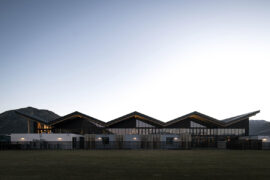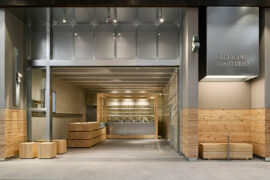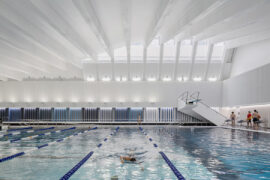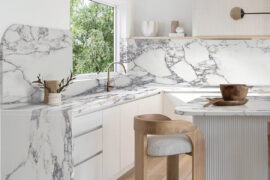Shannon Peach, co-director of Milieu, gives insight into the changing landscape of property development and its convergence with hospitality.
Shannon Peach, co-director of Milieu, has over fifteen years of experience in the property development market. We catch up with him leading up to FRONT – here’s a sneak peak but make sure you catch Shannon at FRONT during his speaker series seminar!
Shannon Peach: Our focus is to create spaces of influence, both inside and out – we aspire to create well-designed liveable and individual buildings. We’re inspired by the physical and social setting of Melbourne, and in turn, aim to contribute to this environment with all our projects.
Consistently our key principles and influences are always at the heart of each project. Yet we are also evolving from each project and are continuously refining our end result from one venture to the next taking in each individual context.
Milieu Property is driven by a commitment to strong architectural outcomes and progressive urban design, we specialise in crafting small to medium scale developments within Melbourne’s most attractive inner-city enclaves. Our level of consideration towards the local context is of utmost importance in every design and build with a strong focus on creating a desirable place to live through the addition of a restaurant (for example).
We find our collaborative relationships to be another real strength, working closely and consistently with likeminded people, in particular with architecture practices DKO and DesignOffice, we have and continued to build these positive relationships from one project to the next.
Milieu Hospitality offers a deep thoughtfulness in creating an extension to one’s home rather than designing an entirely separate venue. The importance we place on creating a relaxed, welcoming and cohesive space not only adds value to the residents but is also aimed at a welcoming spot for locals within the area.

Congress, a hospitality project by Milieu as part of its Peel by Milieu development. Photo by Sharyn Cairns.
Our recent collaboration with DesignOffice at Peel by Milieu, Congress, and now Bedford by Milieu; are prime examples where working with the same design team across both projects can holistically tie the entire experience together and enliven the space.
We take time to understand and respect the existing neighbourhood, in turn creating venues that bring something new and respond to the hyperlocal context. This is about enhancing the area and being an active part of the community.
Amenities makes property valuable. You can’t get better proximity to amenity than living on top of your favourite restaurant, café or bar. Evidently, developers are seeing that there is increasing value in retaining the ground floor, as it’s a perfect opportunity to add to the long-term value and experience for the occupant.
I believe there is definitely an increase in developers taking ownership of this sector. Small-scale residential developers are far more sophisticated than they used to be and there is significantly more competition and pressure.
To us, our brand, philosophy, and reputation is of the highest importance and taking ownership of the hospitality element in our projects allows us to positively impact the end result and therefore create a desirable place for residents to live and enjoy after completion.
I think the concept is relatively new to Melbourne and Australia, as generally high density ‘apartment’ style of living has been quite new in the past decade.
It’s really an extension of a concept used by high-end hotels and office buildings for decades, if not longer, that considers the importance of the ground floor public offering to have a huge impact on the experience of the inhabitants of the building. They recognised this because the owners had an ongoing interest to protect and foster. This is how we see our buildings, even though they are individually owned.
We describe our business as socially and environmentally ‘conscious’, where we consider our impact on both these aspects and minimise our negative impact. Wherever we can invest in initiatives that are the best in our industry, we do.
A recent example is a new development in Brunswick called Breese Street, where we are currently working on a 7.5-star rated project. We have really noticed that buying and building with sustainability in mind, especially in the inner city, has been important to off-the-plan purchasers in recent times.
The building is set to exceed a 7.5-star average energy rating and will require no split systems for heating or cooling thanks to thermal efficiency. These philosophies are much more than box-ticking bolt-ons – no fossil fuels will be consumed to heat, cool or cook in the apartments. In fact, the building’s sustainability specs extend to sourcing reclaimed timber flooring from old schools and church halls, as well as a dedicated compost area to minimise food waste and contribute to productive rooftop vegetable gardening.
Similarly, we are taking sustainable steps within our hospitality sector where Congress is a leading contributor to our community ‘veggie spot’ garden initiative. Where possible, Congress locally sources its produce as well as utilises its own veggie patches.
As the social profile of Collingwood in inner Melbourne continues to evolve, we felt there was an opening for a friendly neighbourhood bistro that would offer a welcomed interest from both new Peel by Milieu residents, and existing locals within the area.
The design is understated, welcoming and highly considered, it’s a beautiful extension to one’s home without being contrived.

For a suburb unrecognisable from its recent past, Congress is a refined yet approachable meeting place and aims to establish itself as one of the local regular destinations – a central point that brings likeminded neighbours together for a casual but considered glass of wine or bite to eat.
Through the building design by DKO, the space acts as a warm glowing beacon for passers-by who can engage with the space via the rotating artwork featured on the vast amount of glass externally. Inside, the concept of neighbourly conviviality extends to the interior design; imagined by Collingwood locals DesignOffice with a democratic appeal.
Double-height glazing wraps the corner site, exposing the interior to the street with unabashed openness, while a solid oak ceiling adds warmth and architectural detailing, rising from the entry to a rear mezzanine where intimacy is enhanced for the diner. The Congress hanging time clock is a cheeky nod to the name and is a civic offering to the busy people passing by day and night.
Our advice would be to get all involved together and talking as early as possible. From our experience, the best results come from early, open and consistent creative communication.
Developing positive relationships with the entire team will benefit the end outcome and in turn, will evolve effortless cohesive designs.
INDESIGN is on instagram
Follow @indesignlive
A searchable and comprehensive guide for specifying leading products and their suppliers
Keep up to date with the latest and greatest from our industry BFF's!

CDK Stone’s Natasha Stengos takes us through its Alexandria Selection Centre, where stone choice becomes a sensory experience – from curated spaces, crafted details and a colour-organised selection floor.

Rising above the new Sydney Metro Gadigal Station on Pitt Street, Investa’s Parkline Place is redefining the office property aesthetic.

London-based design duo Raw Edges have joined forces with Established & Sons and Tongue & Groove to introduce Wall to Wall – a hand-stained, “living collection” that transforms parquet flooring into a canvas of colour, pattern, and possibility.

Merging two hotel identities in one landmark development, Hotel Indigo and Holiday Inn Little Collins capture the spirit of Melbourne through Buchan’s narrative-driven design – elevated by GROHE’s signature craftsmanship.

Warren and Mahoney’s The Mill in Queenstown blends architecture, wellbeing and landscape, creating a transparent training facility.

Hecker Guthrie brings a natural, material-led design to Green Cup’s new Chadstone store, pairing pine, steel and glass with a grab-and-go layout inspired by the brand’s fresh, organic ethos.

Making a splash on the hair spa scene, the latest project from X + O makes a little slice of Japan right at home in suburban Melbourne.

The World Architecture Festival has named The Holy Redeemer Church and Community Centre of Las Chumberas in La Laguna, Spain as World Building of the Year 2025, alongside major winners in interiors, future projects and landscape.
The internet never sleeps! Here's the stuff you might have missed

Hiwa, the University of Auckland’s six-storey recreation centre by Warren and Mahoney with MJMA Toronto and Haumi, has taken out Sport Architecture at the 2025 World Architecture Festival. A vertical village for wellbeing and connection, the project continues its run of global accolades as a new benchmark for campus life and student experience.

In creating interior spaces that enhance the wellbeing and experience of people, true responsible sourcing also considers the impact of materials and making.